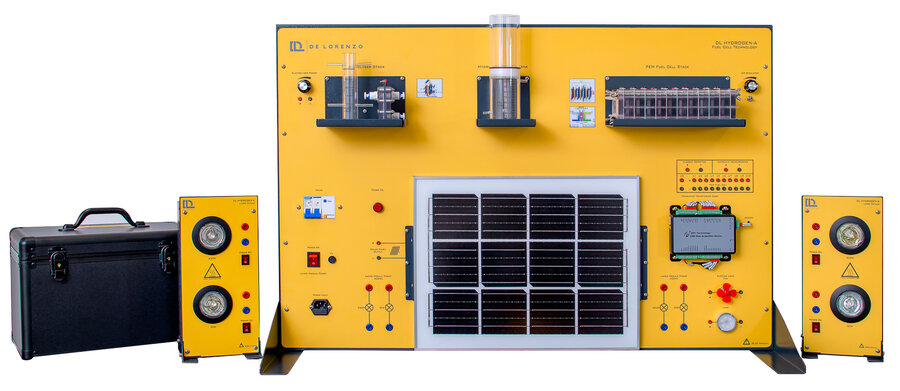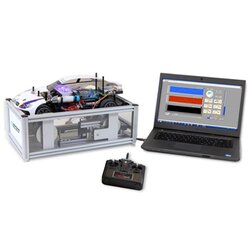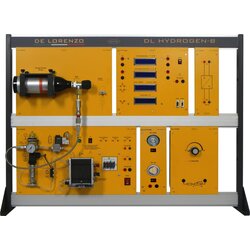Hydrogen Fuel Cells Trainer (DL HYDROGEN-GREEN)


PL-526493
Hydrogen is increasingly emerging as the ideal partner for renewable energy sources such as solar and wind. It is the first element in the periodic table and is also the lightest and most abundant in the observable universe and constitutes approximately 75%. Hydrogen is not an energy source, but an energy carrier, on which great trust is placed globally to meet climate challenges, since it can store and supply large quantities of energy without generating CO₂ emissions during its use.
As an energy carrier, the excess electrical energy produced at peak times by renewable sources such as wind and photovoltaic can be used to produce hydrogen through the electrolysis process and can, therefore, be stored in the form of hydrogen, becoming a reserve of energy to be used in times of shortage or increased demand. The hydrogen thus accumulated can be used as a clean fuel, burned to produce heat, or used in devices called Fuel Cells, to generate electricity in a clean and efficient way.
In recent years, colours have been used to refer to different sources of hydrogen production. “Black”, “grey”, “brown”, “blue”, and “green”. The first three refer to the production of hydrogen from coal, natural gas, and lignite respectively. “Blue” is commonly used for the production of hydrogen from fossil fuels with reduced CO₂ emissions. “Green” is a term applied to the production of hydrogen from renewable electricity.
In general, there are no established colours for hydrogen from biomass, nuclear, or different varieties of grid electricity. So, green hydrogen is produced through a water electrolysis process in special electrochemical cells powered by electricity produced from renewable energy sources, such as solar, wind or hydroelectric energy. This process is considered sustainable since it does not produce CO₂ emissions, making it a clean and sustainable energy source, because only hydrogen produced from renewable sources can really help accelerate the energy transition where electrification is not possible, generating important socioeconomic benefits and environmental.
Therefore, the electrolysis of water powered by energy from renewable sources constitutes the true virtuous path, with zero impact as it does not generate CO₂. The DL HYDROGEN-GREEN trainer was designed to show how to produce hydrogen and consequently energy from a renewable source such as solar energy.
It is composed of:
- A solar panel module to power the electrolyser with relevant output terminals,
- Two modules with lamps to irradiate the solar panel for internal use and powered by the front panel,
- An electrolyser composed of two single PEM Fuel Cells (PEMFC) connected in series with relative power supply for the production of hydrogen,
- A hydrogen storage tank to be connected to the output of the previous PEMFC electrolyser,
- A PEM fuel cell stack, made up of 10 individual cells connected in series, to combine with the environment producing energy, heat and small amounts of water when fuelled with hydrogen,
- A lamp and a motor with a fan as demonstration loads for the electrical energy generated by the fuel cell stack,
- A data acquisition card with PC interface complete with software for data processing and fuel cell monitoring for displaying characteristic curves.
Accessories are also included such as a bottle (with distilled water), protective glasses, silicone tubing, funnel, connection cables and detailed operating manual.
The technical characteristics of some elements are as follows:
- Electrolyser: 15W@4Vcc (voltage range 3÷4Vcc and current range 0÷4A) with H2 production 65cm3/min,
- The stack of 10 fuel cells, each with 200mW (total 2W), generated voltage per cell 0,4÷0,96Vcc,
- Solar panel module: 6V/3,3A,
- Hydrogen storage: 140cm3,
- Lamp for experiments: 4,0÷4,5W,
- Power supply output: 6Vcc/3,3A.
With this trainer students can practice achieving the following training objectives:
- Determination of the characteristic curve of a solar panel,
- Study of a fuel cell stack of up to 10 cells,
- Determination of the characteristic curves of a fuel cell,
- Determination of the characteristic curve of the electrolyser,
- Determination of water decomposition tension,
- Hydrogen production and storage,
- Study of Faraday's law,
- Determination of the efficiency of a fuel cell,
- Assignment of outputs at different operating points of the fuel cell,
- Long-term measurements with PC,
- Monitoring the voltages of individual battery cells on the PC,
- Automatic measurements controlled by voltage and power,
- Data acquisition with wave tracking versus time measurement.
The acquisition software, supplied together with the trainer, has the following characteristics:
- In fuel cell mode: Pmax 10W, allowed voltage 0÷10Vcc, allowed current 0÷5A,
- In electrolysis mode: Pmax 10W, allowed voltage 0÷4Vcc, allowed current: 0 ÷ 3A,
- Measurement, storage and evaluation of various values and characteristic curves of fuel cell models,
- Recording of measured values and automatic or manual execution, with voltage and current adjustments,
- Verification of the efficiency of fuel cells,
- Real-time display of up to 10 individual voltages of a fuel cell stack,
- Recording and display of the characteristic curves and efficiency of the electrolysers,
- Recording and displaying voltage/current, power/time, power/current, power/voltage graphs.
To operate the card, the following are also supplied:
- Connections for 2mm terminals,
- Monitoring cables and USB cable.
Supplied complete with detailed practical manual.
What is this?
These percentage scores are an average of 0 user reviews. To get more into detail, see each review and comments as per below
If you have used this product, support the community by submitting your review



